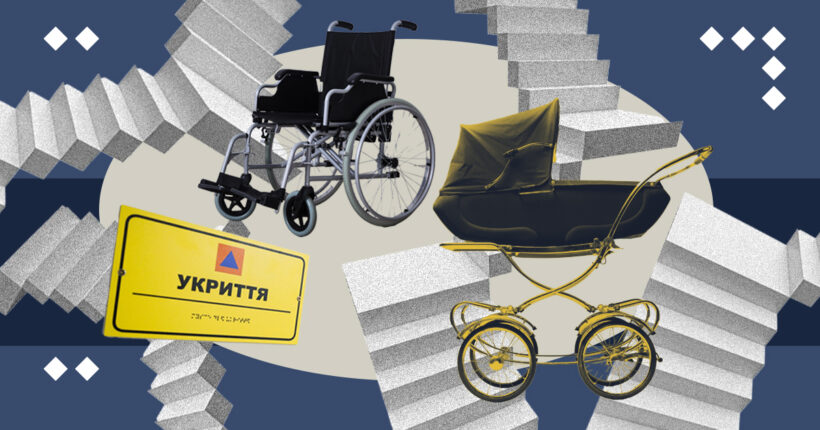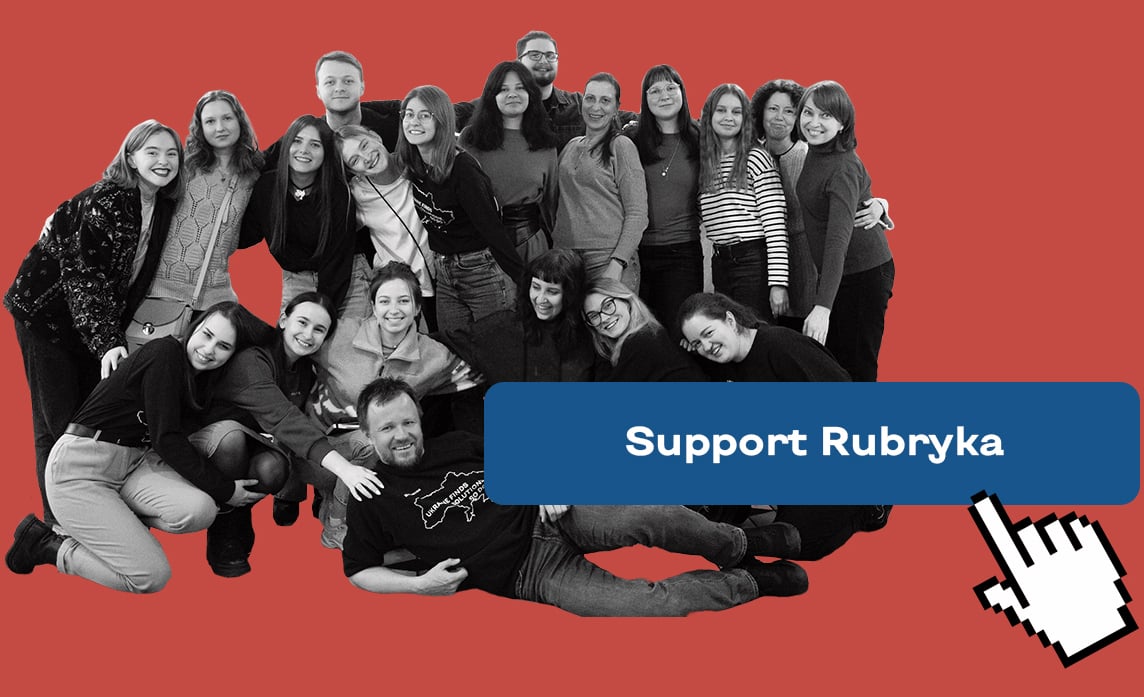
What's the problem?
Bomb shelters have served as critical lifelines for Ukrainians since Russia unleashed its full-scale war in 2022. They protect from air raids, artillery shelling, and other attacks while being the place for community and mutual support. For people with disabilities or limited mobility, accessible bomb shelters are crucial to have a fair chance of reaching safety during emergencies.
According to the Ministry for Strategic Industries, less than 10% of Ukraine's 60,000 shelters are accessible to people with disabilities and other groups with mobility issues. Only 12.5% of 4,013 shelters in the Ukrainian capital, Kyiv, are designed to accommodate people with disabilities.
What's the solution?
Two shelters in Kyiv were made accessible by Fight For Right, a human rights organization founded in 2017 by people with disabilities. The team spent more than six months surveying shelters in the capital and across Ukraine to assess their accessibility as part of the "Promoting Accessibility of Civil Defense Structures" project.
Karyna Hrytsiuk, a project manager with Fight For Right, discussed with Rubryka how the organization made the bomb shelters on Borshchahivska Street and Vatslava Havela Street in Kyiv inclusive for all.

How does it work?
On the eve of the great war
The effort to upgrade two Kyiv shelters began before Russia's full-scale aggression. As tensions rose, Fight For Right started collecting information on safety for people with disabilities during emergencies. The team held talks with government agencies about the accessibility of covers, bomb shelters, and evacuation routes. They also studied international standards and practices. On February 24, 2022, when Russia began its invasion of Ukraine, Yulia Sachuk, the organization's leader, had a meeting scheduled with representatives from the Ministry of Internal Affairs to discuss shelter accessibility.
"International humanitarian law, which countries must follow during wartime, clearly states that governments must protect civilians, including people with disabilities, families with children, and the elderly. It means adhering to the principle of 'leaving no one behind' in rescue efforts," Fight For Right says. "Since the full-scale invasion began, the shelter situation has caused widespread outrage. They are often locked during air raids, poorly equipped, and can feel more like traps than safe-havens.
For people with disabilities, the situation is particularly dire. Apart from locked doors, shelters often have physical barriers, lack accessibility features, and are filled with obstacles on the way in and within the shelter itself."

A shelter for patients in one of the hospitals in the northeastern city of Kharkiv, constantly bombarded by the Russian army. Photo from the Fight For Right archive
A year had passed since the large-scale war began, and the shelter situation did not improve, according to Karyna Hrytsiuk. She points out that if you look at the map of shelters on the Kyiv City Administration website, many are marked as "underground passage with a ramp," "underground parking with a ramp," or "basement with a ramp." However, these "ramps" are often just metal rails that are not only unrelated to accessibility but are also dangerous to use. Fight For Right began to look for resources to raise awareness of the issue and work toward improving accessibility for people with disabilities.
What the shelter survey revealed
Last summer, with support from the British Embassy, Fight For Right launched a field study on shelters in Kyiv and other regions. Local activists, volunteers, accessibility experts, people with disabilities, and government representatives participated in the survey. The entire process was documented in photos and videos to show the condition of shelters and the path leading to them, including entrances, doors, corridors, and restrooms. The inspection followed a checklist developed with Volodymyr Vysotskyi, an expert in architectural accessibility and inclusive social practices.

Steep stairs in one of the shelters in the eastern city of Kramatorsk, often attacked by Russian forces
When the organization's team received monitoring reports from activists, they hoped to find at least one shelter that met accessibility standards and truly cared about people's safety. But even in Kharkiv, a front-line city heavily bombed due to its proximity to Russia, the survey results were disappointing.
"Our activists inspected three Kharkiv shelters. One used to be a full-scale bomb shelter and radiation-proof bunker, but now it lacks airtight doors, restrooms, and ventilation systems. It's completely inaccessible to people with disabilities. The other two civilian shelters in residential buildings were even worse — low doorways, unlit rooms, leaking pipes, and no emergency exits or restrooms," the team said.

An above-ground concrete shelter in the east-central city of Dnipro
In Dnipro, activists couldn't find a single shelter that met accessibility standards. In the neighboring Poltava region, they found no ramp, no high-contrast markings on stairs or thresholds, and no visual or tactile navigation systems, even in a newly built shelter in the village of Velbivka. The survey results were similar in other regions.
"Since August 2023, our organization has inspected over 20 Kyiv shelters, including ones in residential buildings, schools, hospitals, and dormitories. All of them were inaccessible, with most in terrible condition," says Fight for Right project manager Karyna Hrytsiuk.
Making shelters accessible

This is how the shelter on Borshchahivska Street in Kyiv looked before the organization's renovation
Simply highlighting the inaccessibility of shelters for people with disabilities wasn't enough. So, Fight For Right decided to lead by example and show how this problem could be solved. They demonstrated that even a small team could make a difference and transform a shelter to help people with disabilities preserve the most valuable thing: life.

Tactile guides on the floor in the renovated shelter
"We could establish a collaboration with Kyiv City Council member Kseniia Semenova, who informed us about the local government's plans to renovate shelters and invited our organization to get involved. Our priority was to make shelters accessible in places where people with disabilities live," says Karyna Hrytsiuk.

Handrails in the remodeled shelter
They chose shelters in two residential buildings for the project. After consulting with experts and following the latest state building codes (DBN V.2.2-5:2023 "Protective Structures for Civil Defense"), they developed a plan, bought all the necessary materials, and started the renovation.
The team installed handrails, mnemonic schemes to help navigate the shelters, tactile guides on the floor, Braille signage on the walls, reflective strips, and comfortable benches.

Benches in the shelter on Borshchahivska Street
The shelters were also equipped with restrooms that are accessible to everyone, including people who use wheelchairs.

Accessible restroom in the shelter
Did they succeed?
"Let me be clear: this is a pilot project, and it's not perfect, but I'm extremely pleased with the results. Alongside Fight For Right, we implemented several inclusive solutions that made these shelters much more welcoming for anyone seeking safety during air raid alerts," says architectural accessibility expert Volodymyr Vysotskyi.

The entrance to the shelter on Borshchahivska Street
The accessible shelter at 173/187 Borshchahivska Street in Kyiv is open to residents of the surrounding buildings. During the shelter's opening presentation, Kyiv City Council member Kseniia Semenova stated:
"For 2024, the Kyiv budget doesn't allocate funding for shelter repairs in residential buildings or for adapting shelters for people with disabilities. Nevertheless, Fight For Right doesn't give up and advocates for the interests of people with disabilities, whose numbers are growing due to the war."
When Rubryka wrote this article, the organization was finishing the final touches at the second shelter on Vatslava Havela Street. According to Karyna Hrytsiuk, the team had already received positive feedback from residents. They were grateful to everyone involved in the renovations, as the shelters are now much more pleasant to use and accessible to people with disabilities living in the building and nearby areas.
The general takeaway from the initiative is that success requires collaboration with all stakeholders. All parties should be involved from the planning stage.
"We wanted to show the city council that making shelters accessible doesn't require outrageous amounts of money. All it takes is dedicating about a quarter of the renovation budget to accessibility, as it benefits everyone, not just people with disabilities. During air raid alerts, everyone prefers a ramp over stairs, everyone needs a place to sit during long alerts, and everyone should have access to a restroom," says project manager Karyna Hrytsiuk.
However, Hrytsiuk notes that local authorities should not create separate accessible spaces and must apply a broad approach.
"We need to understand and implement a straightforward idea — everything should be accessible. People with disabilities need more than just pharmacies, clinics, or bomb shelters. They need to access everything. Nothing should be built that isn't accessible to everyone," says Karyna Hrytsiuk. "The number of people with disabilities is increasing due to the war, and they won't agree to stay at home and be unable to move around their city. We always encourage the community to come together and approach the authorities as a unified group, asserting their rights. We also encourage the authorities to include people with disabilities in decision-making from the planning stage."
More practical solutions!
The Fight For Right hopes other cities will follow their nonprofit's example. To achieve the same success, citizens must contact their local government representatives. When reaching out, they must include data on why a building isn't accessible for people with disabilities, along with photos and videos. They can team up with other concerned community members for better results and collectively push for change.
Based on the experience gained during the shelter surveys, the Fight For Right organization has also developed a method for assessing the architectural accessibility of civil defense structures. This straightforward guide can help inspect and adapt shelters to ensure accessibility for everyone. The checklist can be helpful for local councils and administrations planning shelter renovations.








